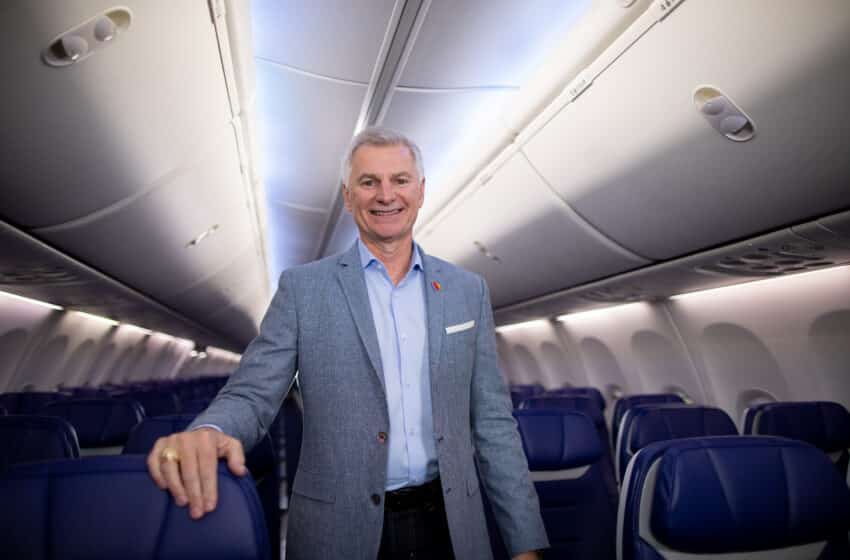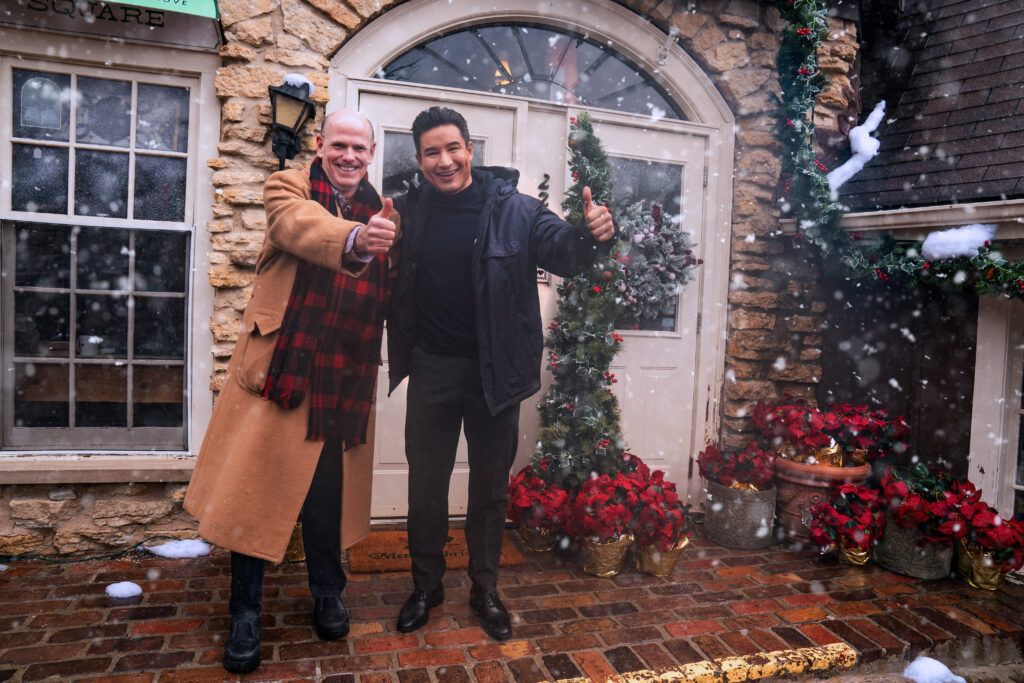Bob Jordan Takes Flight

Southwest Airlines incoming CEO Bob Jordan. // Photo by Stephen M. Keller
Southwest Airlines’ new CEO is poised to pilot the company through uncertain skies ahead. Here’s how he got to his new role and what he sees for the future of the airline.
On February 1 of this year, Robert “Bob” Jordan woke up as CEO of one of the Texas’ most iconic brands.
Seven months before, Jordan had been selected as the new head of Southwest Airlines. It would be his 15th role at the company, where he was first hired as a programmer in 1988.
I spoke with Jordan at 8:00 a.m. on that first day and asked how it felt. “It’s funny,” he said, “it feels like a normal day. It doesn’t feel all that different.”
Jordan attributes this sense of normalcy to the long transition period he went through with former CEO Gary Kelly, who has been Jordan’s mentor for decades. “I’ve had the greatest teacher in the world for 32 years with Gary Kelly. I just can’t thank him enough. He’s always sponsored and mentored me, and he did the same through the transition.”
This year, Southwest will be one of about 50 to 60 companies in the Fortune 500 that experience a CEO changeover, a number that’s been relatively stable the past few years. For any organization, these transition periods pose certain dangers, and the colorful, Texas-born airline is no exception.
But fortunately for all involved, Bob Jordan appears uniquely prepared for his new job. Among the reasons why are that lengthy planned succession that began in mid-2021, Jordan’s deep familiarity with Southwest’s business and culture, and—maybe most significantly—his previous success in heading Southwest subsidiary AirTran Airways.

Acquiring AirTran: A Key Proving Ground for the Future CEO
When Southwest acquired AirTran in 2011, it expanded the airline’s reach by 21 cities, including 7 international destinations. And though Southwest saw the buy as a smart opportunity, to outside observers the AirTran acquisition was by no means a guaranteed win.
Industry watchers wondered whether such a large-scale integration was possible without significantly raising Southwest’s operating costs. In addition to the usual cultural pitfalls of merging organizations, AirTran’s fleet would add new aircraft types to Southwest’s fleet of solely Boeing 737s. Operating just one type of craft gave Southwest an advantage in efficiency. AirTran also used a “hub and spoke” route model, while Southwest famously ran on a “point to point” system.
As new AirTran president, Jordan was tasked with overseeing these challenges. It’s the sort of “mini CEO” role that can be a proving ground for executives on their way to the corner office. And by nearly all accounts, Jordan did prove himself at AirTran, paving the way for his current role.
“I was blessed to lead that acquisition,” says Jordan. “We knew the financial potential was there. You can tell that by reading a couple of pages. But it has to make sense culturally too. You can have a financial success but if it’s a cultural disaster, it’s just not going to work out.”
Jordan led smart measures such as leasing out AirTran’s 717s to Delta, thus retaining the operational efficiency of flying a single aircraft type, the 737. But when asked about why the acquisition overall was a victory, Jordan focuses on the people side.
“The culture of AirTran was very similar to the culture of Southwest Airlines,” he says. “It took me less than two weeks to understand that the AirTran folks loved to serve, love their company, just like Southwest Airlines folks love to serve and love their company. So we had a match in terms of culture, which was key.”
Southwest was intentional in how it brought AirTran employees into the Southwest family. For a time, Jordan spent every week in Atlanta, at AirTran’s main hub, or in Orlando, at its headquarters—being visible, talking to people, helping them understand the common vision.
He also oversaw an onboarding program in which each AirTran employee was paired with a Southwest employee. It was a measure that brought a personal touch to the integration of the two workforces and cultures, no small factor in the success of such an acquisition.
Filling Big Shoes
Despite his previous successes, Jordan has a lot of work on his hands at post-pandemic Southwest, and some big shoes to fill.
Jordan is the sixth CEO in Southwest’s history, a lineage that includes cofounder Herb Kelleher, one of the country’s most well-known and respected CEOs and an undisputed Texas legend.
The company’s founding story tells of Kelleher and a client of his law firm, Rollin King, talking over a business idea in San Antonio’s St. Anthony Club. Start an airline? Why not? Grabbing a cocktail napkin, King sketched out the primary routes he pictured, between Dallas, San Antonio, and Houston: the Texas Triangle.

Kelleher and Rollin incorporated Southwest in 1967, but it took four years of legal wrangling before their first flight. Competitors filed lawsuits, and Kelleher—offering to represent the company and pay legal fees from his own pocket—eventually triumphed before the Texas and US Supreme Courts. In 1971, Southwest’s first flight took off from Love Field, headed for San Antonio.
Lamar Muse and Howard Putnam both held the CEO role early in Southwest’s history, but both had relatively short tenures. After Putnam’s departure for Braniff Airways, Kelleher himself took the reins for over two decades. It was during this period that Kelleher’s personality—outsize, outrageous, fun-loving—really imprinted on the company culture, setting the template for the airline we know today.
Gary Kelly, who now serves as executive chairman of Southwest, was the next titan in the company’s history. He was promoted to CEO in 2004 after being mentored directly by Kelleher.

Like his predecessor, Kelly began his CEO tenure with a legal fight, this time against the Wright Amendment. The bill, which was intended to protect then-new DFW International Airport from nearby competition, limited Love Field—and thus Southwest—from flying passengers beyond Texas and its four neighboring states (Louisiana, Arkansas, Oklahoma, and New Mexico). But with the help of the two US Senators from Texas, Kelly led the charge against the amendment, and it was eventually phased out.
The whole country—and beyond—was now Southwest’s oyster.
During his tenure, Kelly also modernized the fleet, introduced international flights, and added a connection to Hawaii in 2019. That last development was particularly critical because it allowed leisure travelers to spend points from the cobranded Chase/Southwest Rapid Rewards Visa card on vacations to Hawaii.

Of course, Kelly also shepherded Southwest through the pandemic, which saw the first break in 47 years of unbroken profitability for the company. As the airline fights its way back from an industrywide crisis, it has seen travel demand resume and grow. In fact, it managed to open flights to 18 new cities during the pandemic.
That doesn’t mean Jordan doesn’t face some daunting challenges, but he does have an asset in his deep and varied background at Southwest.
“It’s Surreal”
Bob Jordan wasn’t born in Texas, but he got here quick.
A native of Jeffersonville, Indiana, Jordan attended Texas A&M in the late 1970s and early 1980s, studying computer science and then getting his MBA. From there, he did a short stint at Hewlett-Packard’s offices in Cupertino, but was soon itching to come back to Texas.
His introduction to Southwest came via a want ad for a programmer. “In a literal newspaper!” laughs Jordan. He got the job, moved to Dallas, and soon applied for a different finance role under then-controller Gary Kelly.
I asked Jordan if he knew then what he ultimately wanted to do at this early stage of his career. “Pay off my student loans,” he jokes. But he goes on to say that, even from the start, he was never particularly ambitious about career matters. “I love working hard and being around great people, but I’ve never been a title-focused person,” he says. It makes sense that his favorite of the Southwest core values is humility.
We’ve had executive vice presidents who started on the ramp handling luggage. They see you as a person. And they see your capabilities.
“The idea that I would be a senior leader at Southwest, let alone CEO, was not even on the radar for me. To think that 34 years later, Gary and the board would ask me to help lead this company, it’s surreal.”
Though Jordan began as a programmer, Southwest’s leadership—including Gary Kelly, who has mentored Jordan for over three decades—never put him in a box.
“Gary and Southwest Airlines didn’t look at me as a programmer. They looked at me as somebody who could get things done, and they gave me a chance. That’s the beauty of this place. We’ve had executive vice presidents who started on the ramp handling luggage. They see you as a person. And they see your capabilities.”
After applying for his first job under Kelly, Jordan never applied for a job again. “The other 14 of my 15 jobs here, Gary just came to me and said, ‘Hey, why don’t you go do this?’ He had a belief in me a lot of times when I didn’t necessarily have the same belief in myself.”
Kelly notes that, compared with his own experience level going into the CEO role, Jordan has him beat. “It blows me away,” said Kelly.
Making the Most of the “Golden Period”
Former New York Times Company CEO Mark Thompson has called the period between the announcement of a new CEO and that CEO’s assuming the role the “golden period.” It’s a time when the incoming leader can learn, reflect, and get ready.
Jordan says he is grateful for his own seven-month golden period and was determined to make the most of it. He carved out three priorities for the transition, the first being to simply get to know employees better.
“They needed to see me,” he says. “I needed to see them. I needed to talk to them. I spent a lot of time in cities all over the system, in our training classes. It was a joy to be with our employees every single week.”
His second focus was clarifying his message as incoming CEO. “I needed to be able to articulate our short-term and long-term plans in a way that made sense. So I worked on that.” This also involved learning to use tools—like social media—that could help his message clearly reach all of Southwest’s more than 55,000 employees.
Third and finally, he wanted to acknowledge the lasting impact of the pandemic. COVID-19-related issues have been hard on both the company, including causing occasional staff shortages, and the employees personally.
“For a lot of people, COVID wasn’t just the annoyance of not being able to go to a restaurant,” says Jordan. “They lost family members. They’ve been under stress. They’ve had to wear masks all day. I think it’s disrespectful to skip past that and go on to 2022. I felt like we need to spend a lot of time loving on our employees and making sure they understand that we understand, because our employees are the essential difference here at Southwest Airlines.”

Jordan says those months of preparation helped him wrap his mind around the role and start with the same confidence Kelly and the board have in him.
For Kelly’s part, he insists he’s not going anywhere—his new office is just down the hall from Jordan’s. But he is also committed to giving Jordan the space to lead in his own way. “I think it’s very important that people know that Bob is the leader and there’s no confusion there,” Kelly told The Dallas Morning News recently. “I’ll be much more behind the scenes.”
Southwest’s Flight Plan for the Future
When you ask Bob Jordan what’s ahead for Southwest Airlines, it is clear that he did in fact hone his message. Like a good CEO, he repeats the company’s top priorities consistently, including reaching the benchmarks of 5,000 flights a day and 1,000 planes in the fleet. Southwest’s current fleet stands at about 735.
Jordan also says he plans to restore Southwest’s full network of routes and continue hiring. The plan is to onboard 8,000 people in 2022 and bring most of headquarters staff back onsite.
“I think it’s critical to have people together,” says Jordan. “Do I think we will ever come back to a hundred percent in the office? That’s a reach, but can we get to 50 percent or so? I think we can. And I think we need to.”
Additionally, Jordan is working closely with COO Mike Van de Ven, who also took on a president role last year, on modernizing the operation. “We’re nearly a technology company,” Jordan says. He wants to work on particular issues—though the most he will say is that they include having super-reliable WiFi on every flight.

Whatever lies on the horizon for Southwest, Jordan repeatedly returns the conversation to the employees who make the company great.
As any Southwest customer knows, the airline’s employees are known for their humor. The flight attendants are the in-flight entertainment, as people at the company like to say. In 2019, one Southwest gate agent went viral when he entertained delayed travelers with “gate games,” including a competition for worst driver’s license. Another favorite gag is a flight attendant hanging out in an overhead compartment as passengers board.
But it’s not just about the jokes. “Our employees have a warrior spirit,” says Jordan. “They push through and making things happen. We owe them two things: the tools that they need to do their job in the best way possible, and the tools to be as efficient as we can.”
The last question I asked Jordan was whether it’s tough being a CEO when everyone you meet has an experience with your company—perhaps not always perfect.
“It’s wonderful to work at a company where, yeah, we make our mistakes and have our operational challenges but where our customers love us. When people see this heart pin,” he says, indicating his chest, “I don’t have to explain what it means. They say, ‘Oh, you’re with Southwest Airlines.’ The heart means we love to serve each other and our customers.
“If I do meet someone who had a tough experience, I apologize. But the vast majority of comments I get about how people love this company, and above all, about how they love our employees. And it’s those employees who really make the difference here at Southwest Airlines.”





